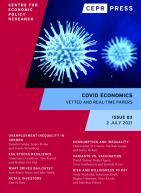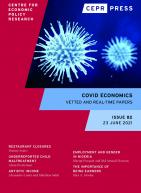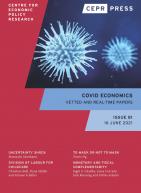
We provide an estimate of the value of a cure using the joint behavior of stock prices and a vaccine progress indicator during the ongoing COVID-19 pandemic. Our indicator is based on the chronology of stage-by-stage progress of individual vaccines and related news. We construct a general equilibrium regime-switching model of repeated pandemics and stages of vaccine progress wherein the representative agent withdraws labor and alters consumption endogenously to mitigate health risk. The value of a cure in the resulting asset-pricing framework is intimately linked to the relative labor supply across states. The observed stock market response to vaccine progress serves to identify this quantity, allowing us to use the model to estimate the economy-wide welfare gain that would be attributable to a cure. In our estimation, and with standard preference parameters, the value of the ability to end the pandemic is worth 5-15% of total wealth. This value rises substantially when there is uncertainty about the frequency and duration of pandemics. Agents place almost as much value on the ability to resolve the uncertainty as they do on the value of the cure itself. This effect is stronger – not weaker – when agents have a preference for later resolution of uncertainty. The policy implication is that understanding the fundamental biological and social determinants of future pandemics may be as important as resolving the immediate crisis.
Citation
Zheng, S, T Johnson, S Sundaresan and V Acharya (2020), ‘The Value of a Cure: An Asset Pricing Perspective‘, COVID Economics 61, CEPR Press, Paris & London. https://cepr.org/publications/covid-economics-issue-61#392514_392937_391059
We exploit geographic variation in the exposure of US banks to COVID-19 and lockdown policies to document the impact of the pandemic and consequent economic crisis on banks. Combining county-level data on COVID-19 and lockdown policies with bank-level data on loan performance and lending growth, and syndicated loan data, we document that banks geographically more exposed to the pandemic and lockdown policies show (i) an increase in loan loss provisions and non-performing loans, (ii) an increase in lending to small businesses, but not in other lending categories, and (iii) an increase in interest spreads and decrease in loan maturities. These findings show that banks have already seen the negative impact of the pandemic and have reacted to higher lending risk with an adjustment in loan conditionality, but have also responded to higher loan demand and government support programmes.
Citation
Keil, J and T Beck (2020), ‘Are Banks Catching Corona? Effects of COVID on Lending in the U.S.‘, COVID Economics 61, CEPR Press, Paris & London. https://cepr.org/publications/covid-economics-issue-61#392514_392937_391060
This study investigates U.S. churches' response to the SARS-CoV-2 pandemic by looking at their public Facebook posts. For religious organizations, in-person gatherings are at the heart of their activities. Yet religious in-person gatherings have been identified as some of the early hot spots of the pandemic, but there has also been controversy over the legitimacy of public restrictions on such gatherings. Our sample contains information on church characteristics and Facebook posts for nearly 4000 churches that posted at least once in 2020. The share of churches that offer an online church activity on a given Sunday more than doubled within two weeks at the beginning of the pandemic (the first half of March 2020) and stayed well above baseline levels. Online church activities are positively correlated with the local pandemic situation at the beginning, but uncorrelated with most state interventions. After the peak of the first wave (mid April), we observe a slight decrease in online activities. We investigate heterogeneity in the church responses and find that church size and worship style explain differences consistent with churches facing different demand and cost structures. Local political voting behavior, on the other hand, explains little of the variation. Descriptive analysis suggests that overall online activities, and the patterns of heterogeneity, remain unchanged through end-November 2020.
Citation
Seabright, P and E Raiber (2020), ‘U.S. Churches' Response to Covid-19: Results from Facebook‘, COVID Economics 61, CEPR Press, Paris & London. https://cepr.org/publications/covid-economics-issue-61#392514_392937_391061
If the 2020 surge in working from home became permanent, how would the distribution of jobs and residents within and across U.S. cities change? To study this question, we build a quantitative spatial equilibrium model of job and residence choice with commuting frictions between 4,502 sub-metropolitan locations in the contiguous U.S.A novel feature of our model is the heterogeneity of workers in the fraction of time they work on-site: some workers commute daily, some always work at home, while others alternate between working on-site and remotely. In a counterfactual where remote work becomes more common, residents move from central to peripheral areas within cities, and from large coastal to small interior cities, on average. The reallocation of jobs is less monotonic, with increases both in peripheral locations and in the highest-productivity metropolises. Agglomeration externalities from in-person interactions are crucial for welfare effects. If telecommuters keep contributing to productivity as if they worked on-site, better job market access drives considerable welfare gains, even for those who continue to commute. But if productivity declines in response to the reduction in face-to-face interactions, wages fall and most workers are worse off.
Citation
Parkhomenko, A and M Delventhal (2020), ‘Spatial Implications of Telecommuting‘, COVID Economics 61, CEPR Press, Paris & London. https://cepr.org/publications/covid-economics-issue-61#392514_392937_390681
This paper aims to highlight the role of supply chain linkages for the transmission of Covid-19 induced shocks based on the monthly trade of the European Union member states. The paper distinguishes demand and supply shocks as of either domestic or partner country origin and further characterizes the role of the latter based on the bilateral GVC positions, thereby taking into account the possibility of transmission through forward and backward linkages. Using the framework of the gravity model, we find a general decline in trade following the Covid-19 outbreak and significantly negative trade effects associated with Covid-19 cases per capita in both origin and destination country. The combined trade effect of Covid-19 is almost minus 20% for both exports and imports, taking into account the average Covid-19 infection rates in the EU and partner countries from April 2020. While export decreases twice as much in response to an increase in the current number of Covid-19 cases in the destination country than in the origin country, it becomes more sensitive to the Covid-19 situation in the origin country over time, suggesting that import demand shocks have a more immediate effect than export supply ones. Moreover, the results confirm that forward GVC linkages act as a channel for the transmission of (demand) shocks in the supply chain trade. An increase in the incidence of destination’s Covid-19 cases, namely, induces a steeper decline in domestic exports of intermediate products in those destinations with which a country has stronger forward linkages, i.e. in partners positioned further downstream. On the other hand, we fail to find robust evidence for the transmission of Covid-19-induced shocks via backward linkages.
Citation
Veli?, A and K Kejžar (2020), ‘Covid-19, trade collapse and GVC linkages: European experience‘, COVID Economics 61, CEPR Press, Paris & London. https://cepr.org/publications/covid-economics-issue-61#392514_392937_390682


Covid Economics - Issue 82
- Restaurant Closures during the Pandemic: A Descriptive Analysis
- Underreporting Child Maltreatment during the Pandemic: Evidence from Colorado
- Covid-19 impact on Artistic Income
- COVID-19, Employment, and Gender: Evidence from Nigeria
- The Importance of Being Earners: Modelling the Implications of Changes to Welfare Contributions on Macroeconomic Recovery
